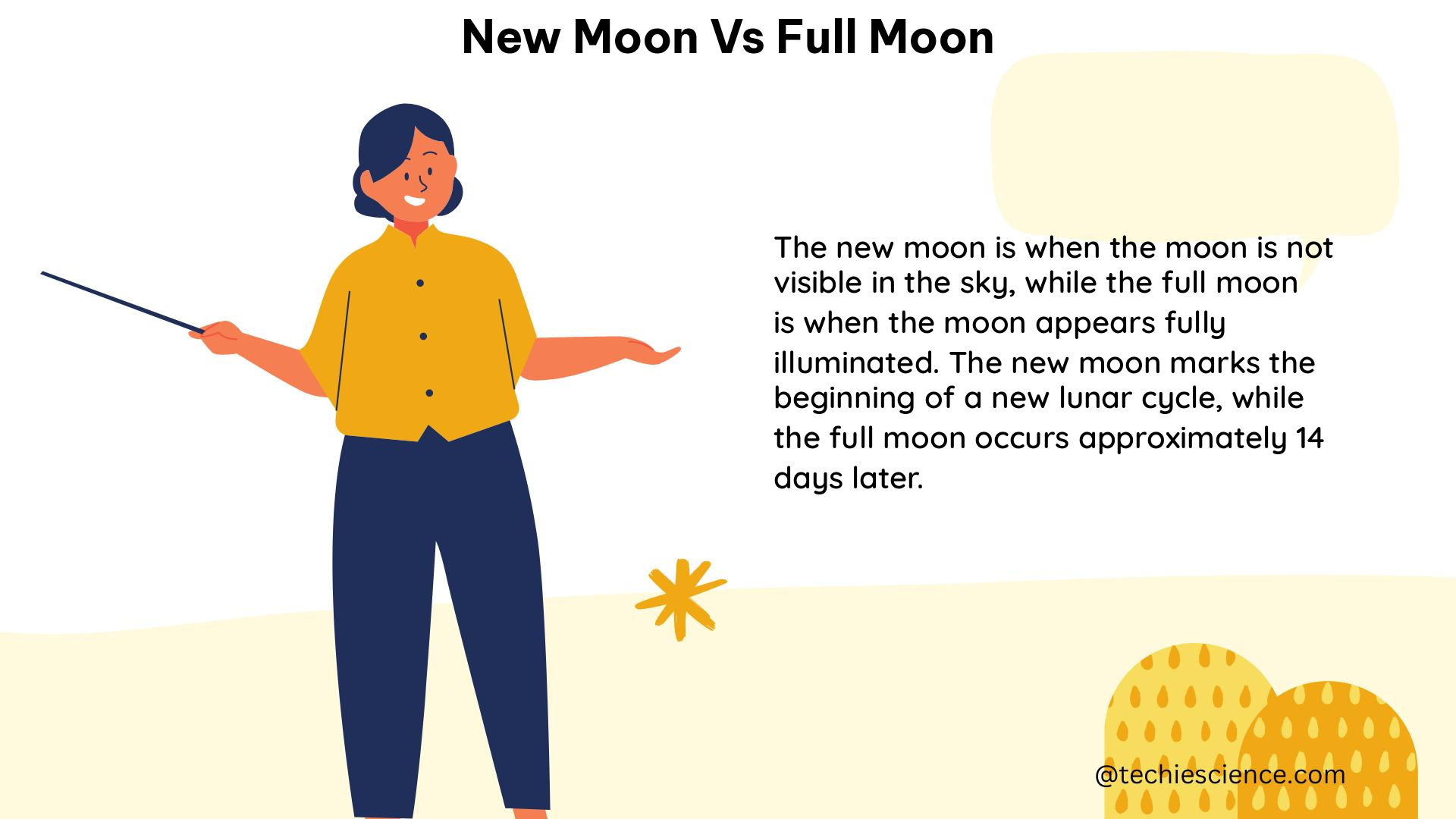The moon’s phases, from new moon to full moon, are a captivating and intriguing aspect of our celestial landscape. Understanding the distinct characteristics and effects of new moon and full moon is crucial for physics students, as these phenomena are deeply rooted in the fundamental principles of astronomy and gravitational physics. In this comprehensive guide, we will delve into the technical specifications, measurable data points, and the profound influence of new moon and full moon on various natural and human-centric processes.
Illumination Percentage and Moon Phase Angle
The primary distinction between new moon and full moon lies in the percentage of the moon’s surface that is illuminated by the sun’s light. During a new moon, the illumination percentage is close to 0%, as the moon’s unilluminated side faces the Earth. Conversely, at full moon, the illumination percentage is nearly 100%, with the moon’s fully illuminated side facing the Earth.
This difference in illumination is directly related to the moon phase angle, which is the angle between the Earth, moon, and sun. At new moon, the moon phase angle is approximately 0°, as the moon is positioned between the Earth and sun. At full moon, the moon phase angle is around 180°, with the Earth situated between the moon and sun.
The relationship between illumination percentage and moon phase angle can be expressed mathematically using the following formula:
Illumination percentage = (1 + cos(moon phase angle)) / 2
This formula allows us to calculate the precise illumination percentage of the moon’s surface at any given moon phase angle, enabling us to accurately predict the appearance of the moon during different stages of the lunar cycle.
Gravitational Forces and Tidal Effects

The moon’s gravitational pull on the Earth is a crucial factor that distinguishes new moon and full moon. During a new moon, the sun and moon are aligned on the same side of the Earth, resulting in their gravitational forces adding together. This enhanced gravitational pull leads to increased tidal ranges, known as spring tides.
Conversely, during a full moon, the sun and moon are on opposite sides of the Earth, causing a partial cancellation of their gravitational forces. This results in neap tides, which have lower tidal ranges compared to spring tides.
The magnitude of the tidal forces can be calculated using the following formula:
Tidal force = G * (M/r^2) * (1 – 3 * sin^2(θ))
Where:
– G is the gravitational constant (6.67 × 10^-11 N⋅m^2/kg^2)
– M is the mass of the moon or sun
– r is the distance between the Earth and the moon or sun
– θ is the angle between the line connecting the Earth and the moon or sun, and the line connecting the Earth and the point of interest on the Earth’s surface
By plugging in the relevant values and calculating the tidal forces, physics students can quantify the differences in tidal effects between new moon and full moon.
Astronomical Phenomena and Eclipses
The distinct positions of the Earth, moon, and sun during new moon and full moon also determine the occurrence of specific astronomical phenomena, such as lunar and solar eclipses.
Lunar eclipses can only happen during a full moon, when the Earth is positioned between the sun and the moon, casting a shadow on the moon’s surface. This is because the moon must be on the opposite side of the Earth from the sun in order for the Earth’s shadow to fall on the moon.
On the other hand, solar eclipses can only occur during a new moon, when the moon passes between the Earth and the sun, blocking the sun’s light. This alignment is necessary for the moon to cast its shadow on a portion of the Earth’s surface, creating the solar eclipse.
Understanding the precise geometrical relationships between the Earth, moon, and sun during new moon and full moon is crucial for predicting and observing these awe-inspiring astronomical events.
Cultural and Spiritual Practices
While the physical and astronomical differences between new moon and full moon can be quantified, there are also cultural and spiritual practices that are deeply rooted in the moon’s phases. These practices are not necessarily based on measurable data but rather on the belief that the moon’s energy and influence can impact human experiences and consciousness.
During a new moon, many cultures and spiritual traditions encourage setting intentions, planting seeds, and starting new projects, as the new moon is seen as a time of new beginnings and potential. Conversely, the full moon is often associated with cleansing, releasing, and letting go of what no longer serves us, as the moon’s energy is believed to be at its peak during this phase.
These cultural and spiritual practices, while not quantifiable, can provide valuable insights into the human experience and the ways in which we perceive and interact with the natural world.
Trading Strategies and Market Behavior
Some traders and investors believe that the moon’s phases can influence market behavior and trading strategies. While the scientific evidence on the correlation between lunar cycles and financial markets is mixed, some traders have developed strategies that incorporate the timing of new moon and full moon events.
For example, some traders may use the new moon as a signal to enter long positions, based on the belief that the new moon’s energy can lead to increased market activity and volatility. Conversely, the full moon may be seen as a time to take profits or adjust trading positions, as the full moon’s energy is thought to have a calming effect on the markets.
It’s important to note that the relationship between lunar cycles and financial markets is a complex and ongoing area of research, and traders should approach such strategies with caution and a critical eye.
Conclusion
The new moon and full moon are not just captivating celestial events; they are also deeply rooted in the fundamental principles of astronomy, gravitational physics, and even cultural and spiritual practices. By understanding the technical specifications, measurable data points, and the profound influence of new moon and full moon, physics students can gain a deeper appreciation for the intricate workings of our universe and the ways in which the moon’s phases shape our world.
References:
- New Moon Versus Full Moon Rituals | It Only Takes A Smile. (2023-02-05). Retrieved from https://itonlytakesasmile.com/2023/02/05/new-moon-versus-full-moon-rituals/
- Phases of the Moon and Percent of the Moon Illuminated. (n.d.). Retrieved from https://aa.usno.navy.mil/faq/moon_phases
- Full Moon/Moon Phases/Lunar Cycles Trading Strategies (Rules …). (2024-05-23). Retrieved from https://www.quantifiedstrategies.com/full-moon-moon-phases-lunar-cycles-trading-strategies/
- New Moon vs Full Moon Manifesting – Mystical Moon Rituals. (n.d.). Retrieved from https://www.mysticalmoonrituals.com/post/new-moon-vs-full-moon-manifesting
- SPY Moon Phase Equity Backtest – spintwig. (2022-07-29). Retrieved from https://spintwig.com/spy-moon-phase-equity-backtest/

I am Raghavi Acharya, I have completed my post-graduation in physics with a specialization in the field of condensed matter physics. I have always considered Physics to be a captivating area of study and I enjoy exploring the various fields of this subject. In my free time, I engage myself in digital art. My articles are aimed towards delivering the concepts of physics in a very simplified manner to the readers.